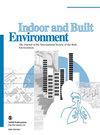当地气温模型和全球热标准模型EN ISO 6946(2017)在数值上是否兼容?
IF 2.9
3区 工程技术
Q2 CONSTRUCTION & BUILDING TECHNOLOGY
引用次数: 0
摘要
研究人员经常使用局部天空温度模型来改进对建筑物热损失的估计。除了局部天空温度模型外,EN ISO 6946(2017)中还实施了一个全球温度模型,如果应用方便,该模型也可能产生合理的结果。为了评估全球和本地模型的竞争力,最好对其结果进行直接的数值比较。到目前为止,这样的比较还没有公布。本研究旨在分析三种天空温度模型之间的计算差异,即Swinbank模型、通用模型和EN ISO 6946(2017)中实施的标准模型。与专门为此目的设计的局部天空模型相比,该研究验证了全球热标准模型在考虑寒冷天空对建筑围护结构影响方面的稳健性。准夜间条件被认为揭示了建筑正面和天空之间长波红外相互作用的主要特征。该研究证明了全球标准模型至少在准夜间环境的条件下能够连续与当地气温模型竞争。本文章由计算机程序翻译,如有差异,请以英文原文为准。
Are the local sky temperature models and the global thermal standard model EN ISO 6946(2017) numerically compatible?
Local sky temperature models are often used by researchers to improve the estimation of building heat losses. Besides the local sky temperature models, there is a global temperature model implemented in EN ISO 6946(2017) that may also produce reasonable results if it is conveniently applied. To assess the competitiveness of global and local models, it is desirable to perform a direct numerical comparison of their results. Such a comparison has not been published so far. This study aims to analyze the computational differences between three models of sky temperature, namely, the Swinbank model, the universal model and the standard model implemented in EN ISO 6946(2017). The study verifies the robustness of the global thermal standard model to account for the acting of the cold sky on building envelopes compared to local sky models specially designed for this purpose. The quasi-nocturnal conditions are supposed to reveal the main features of the long-wave infrared interactions between the building facade and the sky. The study has proved the capability of the global standard model to successively compete with the local sky temperature models at least within the conditions of the quasi-nocturnal environment.
求助全文
通过发布文献求助,成功后即可免费获取论文全文。
去求助
来源期刊

Indoor and Built Environment
环境科学-工程:环境
CiteScore
6.40
自引率
25.00%
发文量
130
审稿时长
2.6 months
期刊介绍:
Indoor and Built Environment publishes reports on any topic pertaining to the quality of the indoor and built environment, and how these might effect the health, performance, efficiency and comfort of persons living or working there. Topics range from urban infrastructure, design of buildings, and materials used to laboratory studies including building airflow simulations and health effects. This journal is a member of the Committee on Publication Ethics (COPE).
 求助内容:
求助内容: 应助结果提醒方式:
应助结果提醒方式:


